The History Of SEAT LEON

The SEAT León (IPA:[le̞ˈon]) is a small family car built by the Spanish car manufacturer SEAT since 1999. It uses the Volkswagen A platform and shares other components with the Volkswagen Golf, Audi A3 and Škoda Octavia.
The first-generation was the hatchback version of the SEAT Toledo, based on the Mk4 Golf floorpan, and drew from the VW parts bin sharing many components in common with the Audi A3 and Volkswagen Golf. As SEAT's best selling car, the León Mk1 was marketed as a sportier and cheaper variant of the Golf. To reinforce the sporty image, the vehicle has aggressive looks and is equipped with firm suspension to improve handling. The more expensive versions are equipped with powerful engines.
Available engines were the 75PS (74hp/ 55.2kW) 1.4 litre 16 valve petrol, 100PS (98.6hp/ 73.5kW) 1.6 litre 8 valve petrol (quickly replaced with a 16 valve 105PS (103.6hp/ 77.2kW) unit) and included two variants of the Volkswagen Group's 20 valve turbocharged 1.8litre powerplant, (with some countries also getting the 2.8litre VR6 delivering 204PS (150kW). The original León Cupra (which became known as the Cupra T) had a 1.8 litre Turbo with 180PS (132kW), and the León Cupra R 210PS (165kW), later becoming 225PS (221.9hp/ 165.5kW). A range of TDI Diesel engines was available, including a 150PS (110kW) version of VW's 1.9 TDI engine, originally sold as a Cupra 4 TDI, with 4 wheel drive, that was sold for 1 year only, and only in certain countries, then passed to Evolution series, then Top Sport and later rebranded as the FR (Formula Racing). Lesser diesel versions were available with 90, 110 and 130PS (128.2hp/ 95.6kW) outputs.
In some countries, a León was available equipped with four-wheel drive, which is based on the same Haldex Traction differential as the VW Golf 4motion. All engines over 130PS (96kW) have a standard manual 6-speed gearbox.
The electric power steering has an additional feature: the Driver Steering Recommendation system. Put simply, software senses when the car is going into a skid and automatically corrects by giving the wheel a quick nudge. Recognising that most drivers find the idea of a car steering itself a little troubling, Seat is quick to stress that the robotic nudge is merely a 'suggestion', which the driver is free to override at any time. A clever idea, if a little weird, which seems to work in practice.
British sales of the Leon were relatively strong, though it couldn't quite match the success of the MK4 Golf upon which it was based - and substantially undercut in terms of value for money.
In Mexico the Leon became a very popular car with upper class young people. The only problem the Leon has suffered in Mexico is the fact that the sport tuned suspension of the Leon is not designed to withstand the constant road imperfections such as potholes and speed bumps that abound in Mexican Roads.
Engine choices
The New León, based on VW Golf Mk5 platform but built in Spain, has a sharper exterior look with vertical windscreen wipers and the external rear door handles more integrated, in a similar style to that seen on recent Alfa Romeo models. Design was handled by Walter de'Silva, and the car uses the same design style that started with the SEAT Altea.
In spite of its sporty image, the engine range is more limited when compared with the Golf's. The base model on offer in the United Kingdom is the old 8-valve 1.6L engine with 102PS (75kW). In some markets (e.g. Greece), the Leon is available with a 1.4 liter MPI engine producing 63 kW/ 85 hp. The sportier variants begin with the 150PS (110kW) 2.0 FSI and the popular 140PS (103kW) 2.0 TDI Diesel. Both are fitted with a standard 6-speed manual with the DSG semi-auto gearbox available as an option. A 185PS (136kW) variant of the 2.0 TFSI unique to the León was later introduced, but despite a low list price and rapid performance attracted only minimal attention and average reviews, so this was later taken off sale to make way for the sportier FR variants.
The first real sporty León within the new range is the León FR with rear twin-exhaust pipes to one side, sport seats and gear stick with FR logo to distinguish it from lesser models, was introduced in June 2006, when it finally received the 200PS (147kW) 2.0 TFSI engine from the Volkswagen Golf GTI, as well as a 170PS (125kW) variant of the 2.0 TDI unit featured in the Golf and Audi A3. While both models retained the 6-speed manual, only the petrol variant can be fitted with the DSG. Further standard equipment includes climate control for the front passengers.
The range-topping model in the León range is the 2.0 TFSI Cupra model. Boasting 240PS (177kW) and a 0-100km/ h time of 6.4 seconds, this model is the fastest and most powerful production SEAT ever. The Cupra comes with standard 18" 5 twin-spoke alloys, red brake callipers and the standard Cupra oval exhaust, as well as new, unique paint finishes and heavily bolstered sport seats complete with the Cupra logo. Also standard are climate control for the front passengers and drilled-aluminium sports pedals.
From 2008 the K1 variant of the León Cupra was introduced, boasting extensively re-worked front and rear bumpers, smart side skirts, a more pronounced tailgate spoiler and unique chrome-tipped, centrally-mounted, oval exhaust.
Engine specifications
* Diesel particulate filter fitted as standard.
One area in which the SEAT León has received positive reviews is the value the car offers when compared against both its sister models, the similarly sized Volkswagen Golf and Audi A3, and rival cars like the Ford Focus, Honda Civic and Vauxhall Astra. UK Prices for the León begin at £11495 for the 1.6 Essence model, with a spec that includes a CD player and electric front windows. For the same kit count and power of engine on a Ford Focus, the cost would be a significant £1500 more.
The Essence variant is no longer available, but began the range and was only available only in the UK, and features a CD player, electric front windows and remote central locking. The Essence was only available with the entry-level 1.6 litre engine. Next comes the Reference, now the entry level model in the UK, which for an additional cost of £700 adds air conditioning. Reference models are available with a 1.6 petrol or 1.9 TDI engine. Stylance adds two-zone climate control, rear electric windows, fog lights, 16" alloy wheels and the option of leather for a further £1000 price premium and is available with the 1.6 or 2 litre petrol or 1.9/ 2.0 TDI engines. Reference Sport adds different 16" alloys as well as heavily bolstered sports seats, in conjunction with the 2.0 FSI and 2.0 TDI engines. Sport trim has been phased out for the 2007 model year but all the features found here are on the new Stylance Sport Pack, including red sports seats and larger 17" alloy wheels.
(Information as of 2006-10-01, from www.seat.co.uk)
See also: SEAT Cupra ChallengeThe first generation SEAT León Cupra R was the basis of a one-make trophy, the Supercopa SEAT León. It ran in Spain, UK, Germany and Turkey from 2003. The car was developed by SEAT Sport and power was raised to 250PS (184kW). An "International Masters" final, featuring the best four drivers from each national series, was introduced in October 2005, as a support race for the Spanish GT Championship's final round at Montmeló. A TDI-powered version has raced in the ECTS, an Italian-based endurance series for touring cars.
During 2005, SEAT introduced the second generation León into the World Touring Car Championship (WTCC) to replace the Toledo Cupra which it had raced in the early rounds of the title . The car features several modifications, including a racing engine that can reach over 260PS (over 190kW), a Hewland sequential-shift gearbox (unrelated to the DSG), and an aerodynamic package for increased downforce (with its hatchback shape, the León is disavantaged against sedans). Minimum weight is 1140kg (2510lb) with driver. SEAT Sport, in partnership with Oreca, runs six cars in the WTCC. Two other cars are run by SEAT Sport UK (Northern South) based in Northampton, UK in the British Touring Car Championship (BTCC). A further two cars are run by SEAT Sport Italia in the Italia Superturismo Championship.
In 2006, the Supercopa León was replaced by the new shape. The car is potentially faster than the WTCC version, as it features a turbocharged 2.0L engine, with over 300PS (over 220kW), increased torque, the DSG gearbox, better aerodynamics (it includes the WTCC car's front and rear spoilers, plus a Venturi tunnel under the car, instead of a flat bottom), and 18 inch wheels, instead of the mandatory 17 inch wheels from the WTCC.
For 2007 the SEAT Cupra Championship in the UK (part of the Toca Package) will run both 'New Leon' Cupra Race cars (300bhp (224kW)) as well as the Mk1 Leon Cupra R race car 250bhp (186kW).
The León has been recently featured in numerous racing video games. It was featured in Need For Speed: ProStreet, Gran Turismo, Microsoft's Project Gotham Racing 2 and Forza Motorsport. The SEAT Leon also appears in the game TOCA Race Driver 2 as a championships series that consist of races that use only the SEAT Leon with similar paint schemes.
It also appears in the SimBin developed WTCC game, "RACE - The Official WTCC Game", which was released in November 2006.
The 2003 Leon Cupra R also appears in Forza Motorsport 2 released in May 2007 on the Xbox 360, and the 2007 Leon Cupra and Leon Supercup are available as a download.
It appears again in Juiced 2
From Wikipedia, the free encyclopedia
More About SEAT LEON
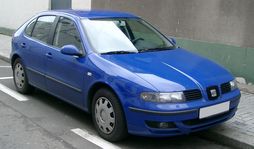
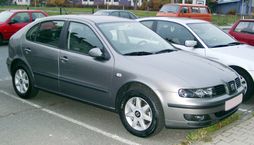
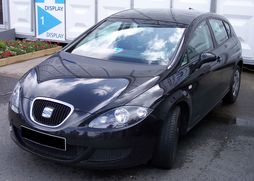
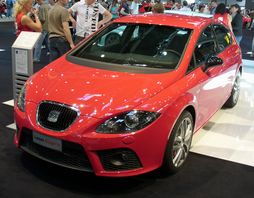
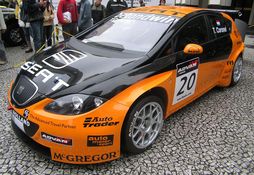
|